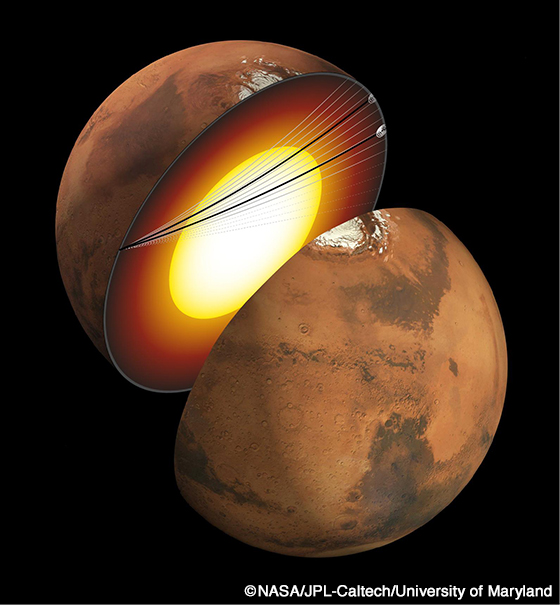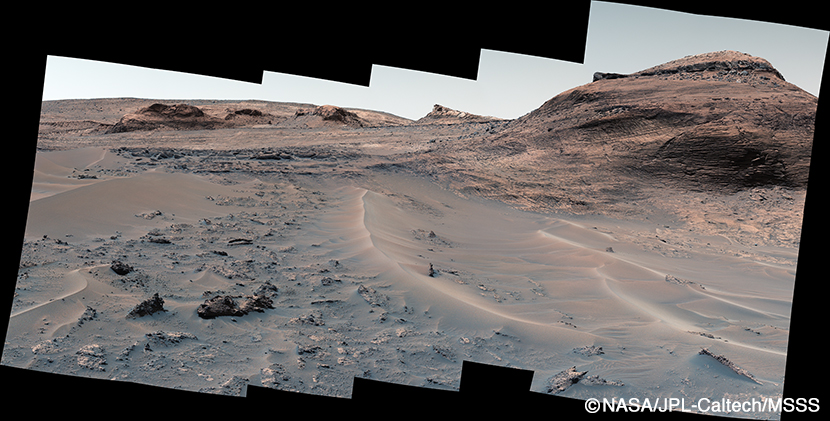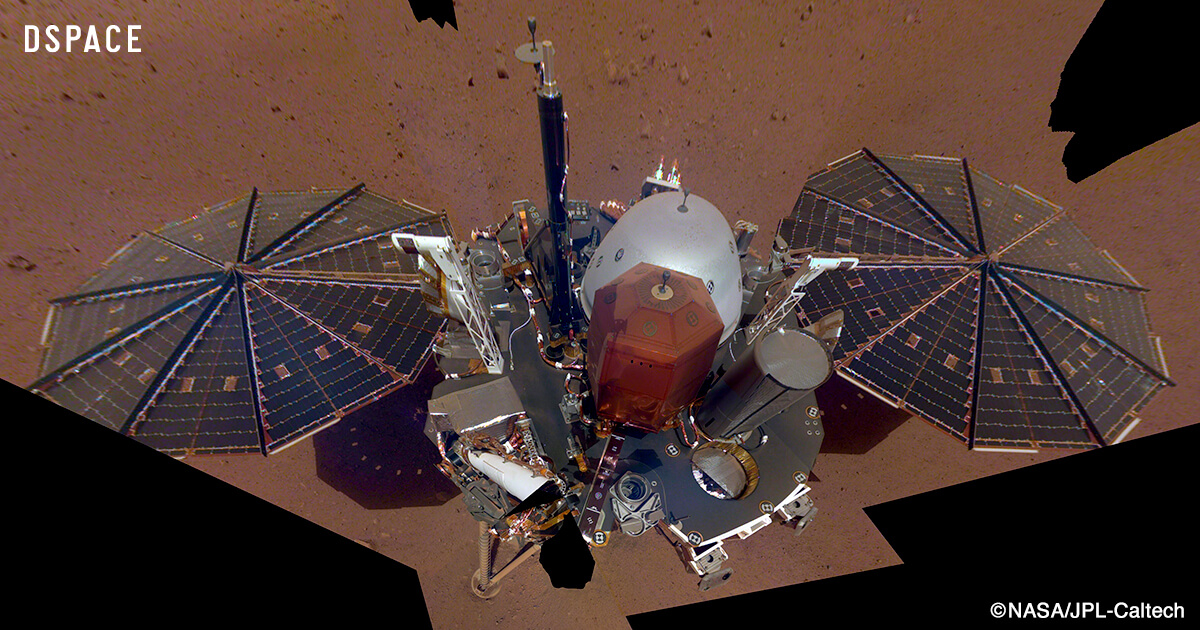Volume 35
Mars’ heart was melting
The InSight rover, which landed on Mars in November 2018, will be decommissioned at the end of 2022.
InSight was the most silent Mars rover ever. He barely moves, just quietly listening to the Martian voice.
Since InSight is equipped with a highly sensitive seismometer, this probe’s mission was to monitor the frequency and magnitude of earthquakes that occur on Mars. In other words, the sound of Mars was the ripples of seismic waves that occurred within it (see: Column XXVII “Did a Celestial Body Collide with Mars? – The Quiet Activity of Insight”).
At first glance, it seems so easy to jump off Earth and go to Mars to look for earthquakes. But it might be hard to find any other way to learn about the planet so effectively. There was a discovery that made me think again.
The discovery is that the core of Mars consists of a thick, molten metallic liquid. And the question of why the entire Martian core melted actually gives us very interesting suggestions about the origin and life of Mars.
This time, let’s talk about the latest message that Insight has sent us: the core of Mars.
An earthquake is nothing but a “shake-up” that occurs within a planet. On Earth, this vibration is caused by rock destruction, slippage, magmatic activity, etc. For us, earthquakes are terrifying and unavoidable natural phenomena that sometimes cause catastrophic disasters, but for seismologists they are a unique tool for understanding planetary interiors that cannot be directly accessed. You can call it an intangible tool of the trade.
For example, the deepest drills on Earth are only 12 kilometers below the surface. Of the Earth’s radius of 6,370 kilometers, this is just a thin layer of the surface. On the other hand, if we use earthquake waves, it will be possible to identify the lower mantle and core, which are much deeper than any human technology can reach.
It’s like a doctor using a stethoscope to listen to the sound inside your body.
Just as a doctor places a stethoscope on the surface of the body to see if there is a problem with an organ, if there is an earthquake, the way seismic waves propagate can provide information such as the type of matter inside the body. The planet is made of and temperature. can know
In 1937, Danish seismologist Inge Lehmann published what may be one of the shortest essays in the history of science. Its address is “P”.
There are two types of earthquakes: longitudinal waves called P waves (waves caused by the expansion and contraction of objects) and transverse waves called S waves (waves caused by displacement of objects). P and S waves propagate radially from the epicenter, travel in the same way within the Earth, and eventually reach the surface. P waves are waves caused by expansion and contraction and can propagate in liquids and solids, but S waves can only propagate in solids because they are shear waves.
Before Rahman, the Earth was known to have a core of liquid metal at its center. This is because seismic waves that occur at the back of the Earth pass through the core, but S waves are not seen in seismic waves.
On the other hand, Lyman noticed that seismic waves made up only of P waves that passed through the nucleus faintly reached places where they were not supposed to, except right behind the epicenter. This strange P wave can be explained by considering the presence of some solid objects in the center of the core, which causes the original P wave to break in the wrong direction. At first, other Earth scientists thought that P waves were caused by errors in its apparatus. Few disproved it, the majority ignored it, and many new theories also suffered.

However, Lyman refuted it by compiling basic data. He showed that it was not due to mechanical error, but that it was undoubtedly derived from some kind of solid—an inner core—within the Earth’s core. It is interesting to see her self-confidence and pride in the fact that her dissertation title is only one letter long, ‘P’. (For those who are interested, please read the short story “Hachigatsu no Silver Snow” by Arata Ayuhara.)
Her thesis convinced the world authorities of the time, and the existence of a solid inner core became widely recognized. In a few years, the common sense of time completely changed, and textbooks were rewritten.
Thus, it was revealed that the Earth’s core has a solid inner core and a liquid outer core.
The primeval Earth began as an ocean of hot magma, initially with a core of completely molten liquid metal. Just as hot miso soup is cooled by convection, the Earth’s hot interior is gradually cooled by convection in the mantle. Then, in the cooled metal core, the liquid solidifies into a solid. Solid metallic iron sinks toward the center under its own weight and forms the inner core.
According to various theoretical calculations, the Earth’s core cooled enough to form an inner core about a billion years ago. If so, given that the Earth formed 4.6 billion years ago, there has been no inner core for more than half of Earth’s history.
Back at the start, the InSight Mars lander found that the Martian core had no solid inner core and was still in a completely molten state. Analyzes of seismic waves – volcanic and meteoric impact – that occurred almost opposite the landing site speak to this fact without a doubt.

Indeed, this is a great surprise and contradiction in terms of comparing Earth and Mars.
First, Mars is only half the size of Earth. In general, large objects cool slowly, and smaller objects cool quickly. It’s the same as hot water in a huge bathtub and hot water in a mug, and the first one takes longer to cool down. Why does the Martian core, which should cool quickly, still melt completely? Even the Earth’s core has already cooled and has an inner core.
Then there is the issue of Mars’ magnetic field. It is known that the Earth’s magnetic field is generated by the convection of the core, which is an electrically conductive metallic fluid. Earth had a magnetic field even before the inner core was formed. Iron oxide minerals found in rocks 2 and 3 billion years old are magnetized by recording the Earth’s magnetic field at that time.
Mars currently has no magnetic field. And even if we reconstruct the magnetic field recorded in iron oxide in ancient Martian rocks, the magnetic field disappeared on Mars after 4 billion years. Why doesn’t the Martian core produce a magnetic field?
Before Insight, it was assumed that the Martian core had completely cooled and solidified about 4 billion years ago, given that Mars is young and that the magnetic field did not exist for 4 billion years. However, Insight completely changed that common sense. Like Angie Lehmann 100 years ago.
Why does the core of Mars melt? Indeed, the answer to this riddle is provided by Insight seismometers.
Simply because the materials that make up the Earth and Mars are fundamentally different. Physically, Mars is not a “mini-Earth,” so comparisons between Earth and Mars cannot simply be made on size alone, and the Martian core does not cool and harden faster than Earth’s.
So what is the fundamental difference between materials found on Earth and Mars?
It’s sulfur. Compared to Earth, Mars has a much greater sulfur content. InSight seismic data shows that the Martian core is much less dense than Earth’s and contains large amounts of sulfur.
With a high sulfur content in the core, iron can remain in a liquid state well below the solidification temperature of pure metallic iron. This is the main reason why the Martian core remains liquid. So it does not mean that the Martian core has not cooled, but that it is made of a material that can remain liquid when cooled.
In the primordial solar system, Mars likely formed from relatively cool regions of matter farther from the Sun than Earth. This is because in such a low-temperature region, sulfur, which evaporates easily, is also abundant in planetary material. This sulfur is distributed to the core during the formation of Mars and is responsible for the liquefaction of the core.
On the other hand, in the region of low temperatures, water is also present in large quantities in the form of ice. Jupiter’s icy moon Europa is a celestial body made of material rich in ice. Europa’s surface is covered in ice and there is a deep ocean inside. However, Mars does not have as much ice or water on its surface as Europa. If Mars formed in a cold region, why didn’t it become an icy planet like Europa?
This problem can also be partly explained by the core. In addition to sulfur, the Martian core may also contain several lighter elements such as hydrogen and oxygen, Insight suggests. Most of the water in the Martian material has been distributed over the core, so the surface may be less watery. In fact, when the core contains a lot of hydrogen, sulfur-bearing iron and hydrogen-bearing iron separate inside the core, which hinders convection. Recent research suggests that this would prevent the formation of a magnetic field on Mars, even if the core is liquid.
Mars appears to be a planet of sulfur.
In the past, sulfur was found everywhere on Mars in the form of sulfates. The excess of sulfur within Mars must have been supplied to the surface by volcanic activity.
The Curiosity spacecraft, which landed in the Gale Crater, which was once covered by a lake, found such sulfates in all layers. In addition, organic matter containing a large amount of sulfur was discovered in the lake layer about 3.5 billion years ago. It is still unknown whether this organic matter is a trace of life on Mars or whether it is organic matter created on Mars in ancient times.

In addition to carbon, oxygen, and hydrogen, life on Earth uses plenty of nitrogen and phosphorous, but not much sulfur. As I mentioned in my previous column, the oceans of Saturn’s moon Enceladus also contain abundant amounts of phosphorus and nitrogen, in addition to carbon, oxygen, and hydrogen (see column 34 “Enceladus and Earth Synchronization”). On the other hand, if life arose on a sulfuric Mars, it wouldn’t be strange to use sulfur instead of nitrogen and phosphorus as the primary component of biomolecules.
Life in the solar system can be physically divided into two types, such as Earth and Enceladus, which use nitrogen and phosphorus, and Mars, which uses sulfur. The insight finally brought us a surprise that made us fantasize about such a forced fantasy.

“Travel maven. Beer expert. Subtly charming alcohol fan. Internet junkie. Avid bacon scholar.”







More Stories
The ranking of the best survival horror games selected by the IGN US editorial team has been released! Resident Evil RE:2 ranked first
Enjoy a hot cigarette while looking at whales and tropical fish under the sea ⁉︎ “Ploom Dive” is an amazing spatial video experience using Apple Vision Pro
Apple Watch now supports sleep apnea, watchOS 11 released – Impress Watch